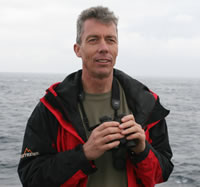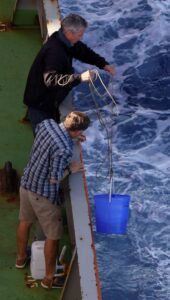
By Peter Ryan, onboard scientist, expert in general ornithology, seabird-fishery interactions, evolutionary ecology, marine debris, solid waste management, biology of oceanic islands.
Leg 1, Day 27.
Today was an action replay (or an inaction replay?) of yesterday, with a regular drizzle of prions and White-headed Petrels, plus the odd dash of Short-tailed Shearwaters. Thirteen bird species were observed, but eight were represented by a single individual (at least in the transect counts). The first White-chinned Petrel for a couple of days didn’t hang about for long, nor did any of the albatrosses, so the stern was largely devoid of birds for the third day in a row.
| Fairy Prion | 190 | White-headed Petrel | 71
|
| Short-tailed Shearwater | 29 | Antarctic Prion | 10 |
| Grey-backed Storm Petrel | 2 | Wandering Albatross | 1+
|
| Grey-headed Albatross | 1+ | Southern Royal Albatross | 1 |
| Northern Giant Petrel | 1 | Southern Giant Petrel | 1 |
| White-chinned Petrel | 1 | Wilson’s Storm Petrel | 1 |
| Black-bellied Storm Petrel | 1 |
No litter was seen, yet we had more kelps than yesterday. But just as we were thinking the Southern Ocean was largely devoid of plastic debris, some bucket sampling revised our opinion.

Tommy Bornman had been finding a few fibres in the underway water supply when he filtered it through a 20-micron mesh. This might have been due to contamination in the lab, but blanks failed to detect any fibres, so we thought that perhaps the intake was close to the laundry outlet. To get around this, we sampled with a bucket from the foredeck when the ship stopped after lunch for a neuston net tow. To our surprise, the 20-litre sample was choked with plastics – mostly fibres but also some fragments. A second sample of 10 litres collected when the ship slowed again at 16h30 yielded fewer fibres but more fragments. It seems that there may be lots of very small plastic items in surface waters, too small for the 200-micron neuston net to detect. Only a small subset of this plastic reaches the underway intake, which is about 4 m below the surface. We shall continue regular bucket sampling in tandem with the underway system to assess the extent of the problem.